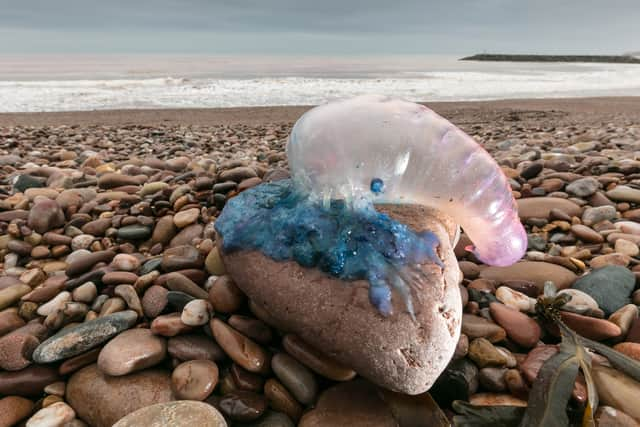Portuguese Man O’War: warning to holidaymakers as ‘fearsome predators’ wash up on UK beach - how to spot
and live on Freeview channel 276
“Fearsome predators” have been spotted on a popular UK beach with holidaymakers warned “not to touch” due to their long stinging tentacles.
As people flock to beaches over the bank holiday weekend they are being warned to look out for Portuguese Man O’War after the species was found washed up in Wembury, a small village off the coast of Devon.
Advertisement
Hide AdAdvertisement
Hide AdLocal kayaker and Devon Wildlife Trust volunteer, Samantha Barnes, reported the sighting on Wednesday morning (23 August). Wembury Marine Centre also reported that many people in recent days had seen them washed up on the beach.
The centre wrote on Facebook: "These beautiful pics of a Portuguese Man O’War were sent in this morning by local kayaker and Devon Wildlife Trust volunteer, Samantha Barnes! We’ve also had a few reports of them washing up on the beach over the past few days - be careful not to touch!"
On its website, Devon Wildlife Trust describes the species as “fearsome predators, catching small fish and crustaceans with their long stinging tentacles.” The Trust added: “It’s these tentacles that you need to watch out for too - they can sting long after the animal has died.”


Despite looking like a jellyfish, the creatures are not in fact one. It is a colonial hydrozoan, made up of small individual animals called zooids - each with their own specific function.
Advertisement
Hide AdAdvertisement
Hide AdThey live at the surface of the open ocean, held afloat by a gas-filled bladder - and the “predators” can’t swim which is why they often end up washed ashore after big storms.
The Trust says it is likely to see Portuguese Man O’War between September and December, but it is rare to spot them on UK shores. They are blown into UK seas on westerly winds and washed ashore on the West Coast of the UK mainly on the Isles of Scilly and Cornwall.
But they are increasingly becoming found in West and North Wales and as far north as Cumbria.
What does Portuguese Man O’War look like?
The Trust says the creature is “unmistakable” with a large translucent purple float, the crest tipped with pink, and long blueish-violet tentacles. The float can be seen bobbing on the surface of the sea, sometimes caught in mats of seaweed.
After they are stranded on the shore the creatures lose their colour quickly and can appear translucent with just a tinge of purple.
Comment Guidelines
National World encourages reader discussion on our stories. User feedback, insights and back-and-forth exchanges add a rich layer of context to reporting. Please review our Community Guidelines before commenting.
